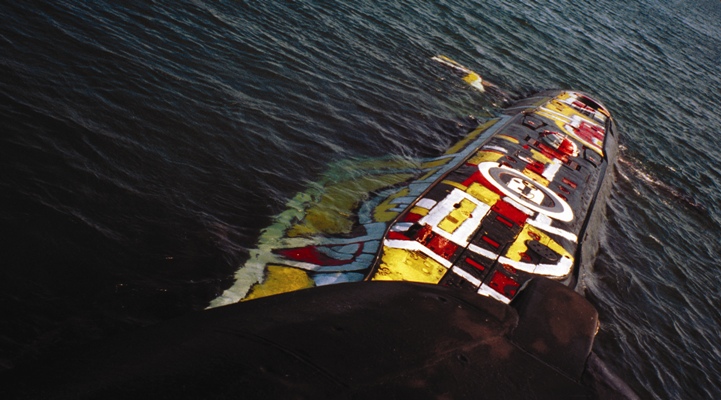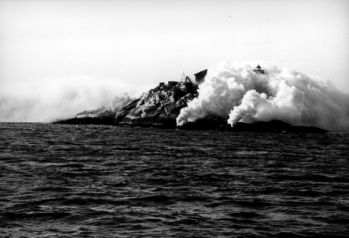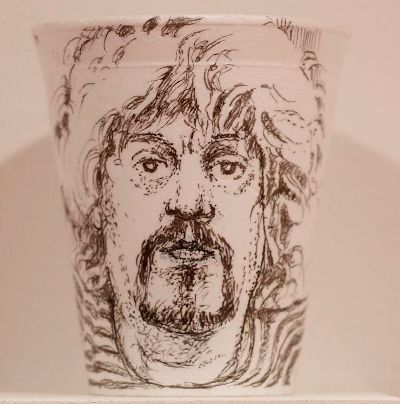Alexander Ponomarev: Sea Stories, Calvert 22 | reviews, news & interviews
Alexander Ponomarev: Sea Stories, Calvert 22
Alexander Ponomarev: Sea Stories, Calvert 22
Epic nautical installations by Russian artist communicate a sense of wonder
As well as being a great artist, Leonardo da Vinci designed machine guns, tanks and cluster bombs and worked out how to build a submarine; but so appalled was he by the potential of this last invention that he coded his notes to prevent anyone using them to instigate what he called "murder at the bottom of the seas".
Murder at sea is exactly what submarines are meant for, of course, while their ability to cruise unseen beneath the waves makes them not only lethal but extremely sinister; more than any other weapons system they have become emblems of predatory stealth and evil intent. Coming across a Russian sub moored in a Venice canal last summer (main picture) was quite a shock, then, especially as it was festooned with brightly coloured patterns. “I performed (Leonardo’s) operation in reverse”, explains Alexander Ponomarev, the Russian artist responsible for its presence, “and made a work of art from a fatal weapon, returning the submarine to the realm of culture.”
 Collectively titled The Northern Trace of Leonardo, Ponomarev’s painted submarines have surfaced as far afield as the Barents Sea, Lake Baikal, Valencia, the Loire, Paris and Greenland. In London, though, we have to make do with a photograph of the decorated hull and a description of the lengthy drinking sessions and sing-alongs needed to persuade the Russian navy to let him paint one of their nuclear fleet and sail in it to the Arctic Ocean and beyond.
Collectively titled The Northern Trace of Leonardo, Ponomarev’s painted submarines have surfaced as far afield as the Barents Sea, Lake Baikal, Valencia, the Loire, Paris and Greenland. In London, though, we have to make do with a photograph of the decorated hull and a description of the lengthy drinking sessions and sing-alongs needed to persuade the Russian navy to let him paint one of their nuclear fleet and sail in it to the Arctic Ocean and beyond.
The fact that Ponomarev once served in submarines as a torpedo officer undoubtedly helped in the negotiations and, when it came to designing Base, 2003, a playful reprise in model form of The Northern Trace of Leonardo, his training as a nautical engineer must also have come in handy. A miniature sub zooms along a nine-metre tube full of water before coming to an abrupt halt; rising into the air, it dries and sheds its dark coating to reveal a mosaic of coloured patterns beneath. Back underwater, though, it resumes its shark-like appearance to skid back along the tube.
 If Base is more like a giant toy than a serious meditation on the relationship between art and weaponry, the video piece Maya: A Lost Island, 2005 (pictured left) invites more thoughtful contemplation of our creative and destructive impulses and the technologies that make both possible. Scratching the surface with a knife, the artist erases from the map the outline of Sedioyatyl, an island in the Barents Sea, while on the large screen we watch the actual island disappear behind a cloud of smoke. Then we are on board one of the vessels commandeered to plant the gas cylinders that produce the cloud and trigger the disappearance.
If Base is more like a giant toy than a serious meditation on the relationship between art and weaponry, the video piece Maya: A Lost Island, 2005 (pictured left) invites more thoughtful contemplation of our creative and destructive impulses and the technologies that make both possible. Scratching the surface with a knife, the artist erases from the map the outline of Sedioyatyl, an island in the Barents Sea, while on the large screen we watch the actual island disappear behind a cloud of smoke. Then we are on board one of the vessels commandeered to plant the gas cylinders that produce the cloud and trigger the disappearance.
As far as I know, the island is of no strategic importance, but seeing the fifth fleet of the Russian navy in operation around its shores brings to mind the Falklands over which we went to war with Argentina, and the Senkaku Islands in the East China Sea where China stages naval exercises beside waters claimed by the Japanese. Associations like these are, of course, intentional. Before joining the navy, Ponomarev studied art and when, in 1981, a prolonged illness forced him to retire from the navy, he began making work that uses his naval experience to ponder much broader issues.
Drawn on a shipping chart, Cutting of the Atlantic, 2010 was inspired by a journey aboard a research vessel tracking the Atlantic round the 60th parallel. Floating above exotic rock formations and heaps of wreckage, a boat lowers a depth sounder that fails to clock the wonders beneath its hull. The scramble is on to lay claim to the ocean floor; a submarine that planted a Russian flag on the seabed beneath the Arctic pack ice was quickly followed by Norway, Canada and others. Ponomarev is not interested in sovereignty, though, but in communicating the sense of wonder engendered in him by the deep.
 Made while on board the research ship, Deep Water Graphics, 2010 (pictured right) uses humour to reveal just how puny we are in relation to the ocean. Having penned a series of self-portraits on polystyrene cups, Ponomarev stuffed them with packaging to prevent them imploding and lowered them four kilometers below the surface where extreme water pressure caused them to shrivel. Beautifully presented inside perspex cubes suspended midway between floor and ceiling as though floating in the depths, the tiny shrunken heads bear eloquent witness to the awesome power of the sea to dwarf and crush us.
Made while on board the research ship, Deep Water Graphics, 2010 (pictured right) uses humour to reveal just how puny we are in relation to the ocean. Having penned a series of self-portraits on polystyrene cups, Ponomarev stuffed them with packaging to prevent them imploding and lowered them four kilometers below the surface where extreme water pressure caused them to shrivel. Beautifully presented inside perspex cubes suspended midway between floor and ceiling as though floating in the depths, the tiny shrunken heads bear eloquent witness to the awesome power of the sea to dwarf and crush us.
- Alexander Ponomarev: Sea Stories at Calvert 22 until 21 November
more Visual arts
 Eye to Eye: Homage to Ernst Scheidegger, MASI Lugano review - era-defining artist portraits
One of Switzerland's greatest photographers celebrated with a major retrospective
Eye to Eye: Homage to Ernst Scheidegger, MASI Lugano review - era-defining artist portraits
One of Switzerland's greatest photographers celebrated with a major retrospective
 Stephen review - a breathtakingly good first feature by a multi-media artist
Melanie Manchot's debut is strikingly intelligent and compelling
Stephen review - a breathtakingly good first feature by a multi-media artist
Melanie Manchot's debut is strikingly intelligent and compelling
 Fantastic Machine review - photography's story from one camera to 45 billion
Love it or hate it, the photographic image has ensnared us all
Fantastic Machine review - photography's story from one camera to 45 billion
Love it or hate it, the photographic image has ensnared us all
 Yinka Shonibare: Suspended States, Serpentine Gallery review - pure delight
Weighty subject matter treated with the lightest of touch
Yinka Shonibare: Suspended States, Serpentine Gallery review - pure delight
Weighty subject matter treated with the lightest of touch
 Jane Harris: Ellipse, Frac Nouvelle-Aquitaine MÉCA, Bordeaux review - ovals to the fore
Persistence and conviction in the works of the late English painter
Jane Harris: Ellipse, Frac Nouvelle-Aquitaine MÉCA, Bordeaux review - ovals to the fore
Persistence and conviction in the works of the late English painter
 Sargent and Fashion, Tate Britain review - portraiture as a performance
London’s elite posing dressed up to the nines
Sargent and Fashion, Tate Britain review - portraiture as a performance
London’s elite posing dressed up to the nines
 Zineb Sedira: Dreams Have No Titles, Whitechapel Gallery review - a disorientating mix of fact and fiction
An exhibition that begs the question 'What and where is home?'
Zineb Sedira: Dreams Have No Titles, Whitechapel Gallery review - a disorientating mix of fact and fiction
An exhibition that begs the question 'What and where is home?'
 Yoko Ono: Music of the Mind, Tate Modern review - a fitting celebration of the early years
Acknowledgement as a major avant garde artist comes at 90
Yoko Ono: Music of the Mind, Tate Modern review - a fitting celebration of the early years
Acknowledgement as a major avant garde artist comes at 90
 Unravel: The Power and Politics of Textiles in Art, Barbican review - the fabric of dissent
An ambitious exploration of a neglected medium
Unravel: The Power and Politics of Textiles in Art, Barbican review - the fabric of dissent
An ambitious exploration of a neglected medium
 When Forms Come Alive, Hayward Gallery review - how to reduce good art to family fun
Seriously good sculptures presented as little more than playthings or jokes
When Forms Come Alive, Hayward Gallery review - how to reduce good art to family fun
Seriously good sculptures presented as little more than playthings or jokes
 Entangled Pasts 1768-now, Royal Academy review - an institution exploring its racist past
After a long, slow journey from invisibility to agency, black people finally get a look in
Entangled Pasts 1768-now, Royal Academy review - an institution exploring its racist past
After a long, slow journey from invisibility to agency, black people finally get a look in
 Barbara Kruger, Serpentine Gallery review - clever, funny and chilling installations
Exploring the lies, deceptions and hyperbole used to cajole, bully and manipulate us
Barbara Kruger, Serpentine Gallery review - clever, funny and chilling installations
Exploring the lies, deceptions and hyperbole used to cajole, bully and manipulate us

Add comment